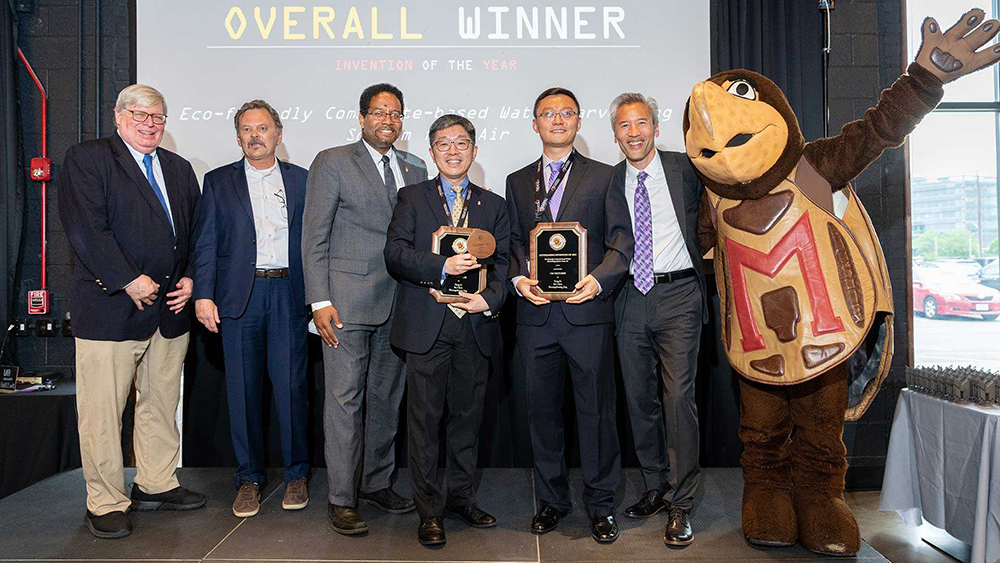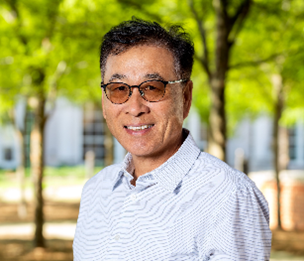News Story
Device That Harvests Water From Air Named Top UMD Invention of the Year

From left, UMD Vice President for Research Gregory F. Ball, UM Ventures, College Park Director Ken Porter, President Darryll J. Pines, Invention of the Year overall winners Professor Teng Li and postdoctoral researcher Bo Chen, Interim Chief Innovation Officer Dean Chang, and Testudo celebrate at Innovate Maryland. Photo by Mike Morgan
Conjuring water from thin air may seem like a trick, but a team of University of Maryland researchers doesn’t use a magic wand. In fact, the group doesn’t even need electricity.
The team’s invention—a solar-powered system that uses all-natural, partly plant-based materials to extract drinkable water from even the most arid of environments—has the potential to fight water shortages around the world, and took top prize yesterday in the university’s annual Invention of the Year competition.
Along with other category winners, the award was announced at Innovate Maryland, a yearly celebration of UMD researchers’ creativity at translating incisive science into innovative, real-world products with the potential to address challenges around the globe.
“They provide proof that the search for knowledge can spark an idea or invention that, in turn, can inspire change, improve lives and benefit humanity overall,” Vice President for Research Gregory F. Ball said of this year’s 12 finalists. “I firmly believe that no grand challenge is too daunting for our world-class researchers to confront head-on and work toward a solution.”
In his remarks, President Darryll J. Pines emphasized the importance of resolve and perseverance in the pursuit of innovation.
“It is risky and challenging and time-consuming,” he said. “But as your peers in these examples show, the potential rewards are limitless. Your inventions, your research, and your ideas can—and will—change the world. By harnessing the creativity and determination in this room, we can truly address the grand challenges of our time and make a better world for everyone.”
Here are this year’s winners:
Overall/Physical Sciences Invention of the Year: Eco-Friendly Composite-Based Water Harvesting System From Air
As a result of growing populations, climate change, poor water management and geopolitical conflict, an estimated 87 countries will be in a state of water scarcity by 2050. While the technology exists to extract potable water from the atmosphere, current processes are not only expensive but energy-intensive—itself an environmental concern.
The Maryland Engineering researchers—mechanical engineering Professor Teng Li, postdoctoral researcher Bo Chen, and former Ph.D. student Shuangshuang Jing–have invented a low-cost, sustainable atmospheric water harvesting system that can be manufactured and set up nearly anywhere on Earth without need for electricity or complex process control. The technology is based on an all-natural, eco-friendly biomass-based composite that can pull water from air anywhere on the planet, including arid environments, powered solely by sunlight. The composite, a foam made of Earth-abundant cellulose and graphite, can absorb over 670% of its weight in water from the air with 90% relative humidity and quickly release 95% of absorbed water under sunlight irradiation in one hour.
“Water is vital for life, yet about 10% of the world population lacks access to it,” said Professor Li. “The atmosphere is a ubiquitous and abundant water reservoir, equivalent to 10% of the freshwater in all lakes on Earth. Our system makes use of that reservoir in a manner that is both efficient and sustainable.”
Information Sciences Invention of the Year: Programmable Creation of All-Natural Plastic Substitutes
Each year, humans generate around 400 million tons of plastic waste. Only about 9% is recycled, with the remainder either sent to landfills—where the waste emits greenhouse gasses as it decomposes in a process that can take up to 500 years—or incinerated, which not only generates emissions but causes significant public health risks from inhaled particulate matter.
To mitigate the effects of plastic pollution on climate change, chemical and biochemical engineering Assistant Professor Po-Yen Chen, doctoral student Tianle Chen, and Liangbing Hu, Herbert Rabin Distinguished Professor in materials science and engineering, have developed a machine learning tool to accelerate the discovery of environmentally friendly, all-natural plastic substitutes. The tool allows users to input physicochemical properties and, in seconds, generates existing or new recipes for sustainable plastic substitutes that match the user’s requirements. At the end of their life cycle, these materials decompose naturally without causing environmental harm.
Life Sciences Invention of the Year: Detection of Ovarian Cancer via the Spectral Fingerprinting of Quantum-Defect-Modified Carbon Nanotubes in Serum by Machine Learning
Annually, ovarian cancer is responsible for 184,000 deaths worldwide. Survival rates are strongly linked to the stage at which the disease is detected, with just a 29% five-year survival rate if the cancer has metastasized—the stage at which most cases are diagnosed. But the survival rate rises to more than 90% if the disease is caught before the cancer has spread outside the ovaries. However, few serum biomarker tests—blood tests that reveal tumor development—are highly specific yet sufficiently sensitive enough to detect early-stage disease.
Researchers YuHuang Wang, a professor of chemistry and biochemistry, Daniel Heller and Mijin Kim of Memorial Sloan-Kettering Cancer Center, Anand Jagota of Lehigh University, and Ming Zheng of the National Institute of Standards and Technology have addressed this problem by using a new type of sensor technology. Based on quantum defect-tailored carbon nanotubes augmented by machine learning algorithms, this new sensor technology can detect the "disease fingerprint" of high-grade serous ovarian carcinoma in serum samples, providing a much more accurate and reliable diagnosis. This breakthrough has the potential to save lives by allowing doctors to catch ovarian cancer early, when it is most treatable.
Quantum Invention of the Year: Low Noise Quantum Frequency Conversion Scheme for Trapped Ion Quantum Network
Networks that take advantage of quantum effects like entanglement and superposition could be central to the future of secure telecommunications. Maryland Engineering researchers Uday Saha M.S. ’21, Ph.D. ’22 and Edo Waks, a professor of electrical and computer engineering with an appointment in the Institute for Research in Electronics and Applied Physics, are bringing that day closer with their development of a method to generate telecommunication photons from a trapped barium ion with a high signal-to-noise ratio.
Using two cascaded stages of frequency conversion, they achieved wide frequency separation with high signal quality and a signal-to-noise ratio about 4.5 times higher than the state-of-the-art approach, with about 2.5 times higher frequency separation. The system and method of the invention provide a clear pathway for achieving broad frequency shifts in the down-conversion of photons from a quantum computer with low noise. This will help to realize optical interconnects for scalable and long-distance quantum networks.
Read the full list of finalists in every category.
Story by Jordan Dunklee for Maryland Today.
Published May 3, 2023









